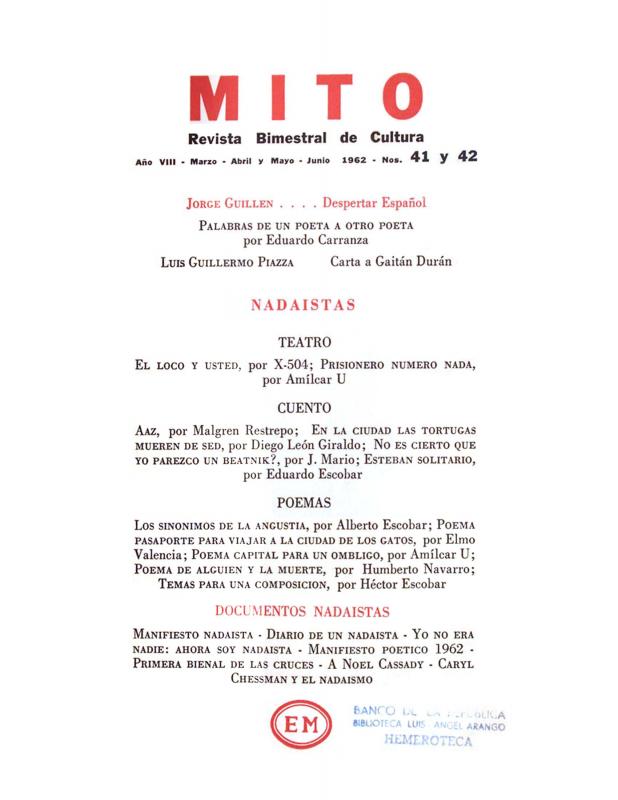The predominantly poetic avant-garde movement known as Nadaísmo [Nothing-ism] (1958–70) was founded in Colombia in the late 1950s; its objective was to challenge the local status quo in terms of the political, lexical, aesthetic, and social standards that were in vogue through the end of the twentieth century. This group was perhaps the only one in the country to pattern itself on the artistic European avant-garde of the early years of the century and write manifestos that clearly evoke that artistic cultural heritage, since the nadaísta manifestos were probably the only documents of that kind ever produced in the history of Colombian art. The manifesto by “Amílkar U.” (1940–1985) was particularly written with the express intention of irritating people, like the earlier ones produced in Europe. In fact, it was part of a poetic form of critical politics that extolled the value of art over history, leisure over middle class postcapitalist production, and poetry—that is, “mystery,” contradiction, “Nothing” or the “Pure Field” of “divine things”—over the “Law of the Good Neighbor” that was observed precisely and colonially by Colombian teachers. Even during the time of the Liberal Republic they were always evidently or discreetly culturally conservative.
The manifesto, with all its obvious Surrealist and Dada influences, demands the establishment of the kind of “real unreality” or “unreal reality” that was revealed to poets at times when artists of the world oversaw a vacuous future ahead. Art was therefore presented as the only true way to raise awareness in the face of government lies regarding the warlike rhetoric of the world economy that was rapidly escalating at a frightening pace on both sides of the Atlantic Ocean. The text takes a no-holds-barred approach to condemning the impositions of the Colombian clergy and the state, and sinks its root into “the terrain of the schizophrenics” of history, such as: Arthur Rimbaud, Vladimir Mayacovski, Adolf Hitler, Joseph Stalin, André Breton, Tristan Tzara, and Søren Kierkegård. In keeping with the dissident spirit of avant-garde movements, the text is riddled with neologisms and loans from scientific (technical and specialized) terminology that is used to attack science and refer to art.
The nadaístas were in constant contact with contemporary visual artists, and worked together with them on certain projects, as in the case of the Festival de Arte de Vanguardia [Avant-garde Art Festival] in Cali (1965) and the Bienal de las Cruces [Las Cruces Biennial] in Bogotá (1962).
Amílcar Osorio Gómez (who used the pseudonym “Amílkar U.”) was a poet, as obscure as he was brilliant, who produced a slender body of work and lived a short life. When he was still a child he wrote shocking works of poetry, and in later years, his pen was explosive, irreverent, intense, informed, and lucid. Though “Amílkar U.” produced one book of poems, another of stories, and one novel, he is still not listed in the history of Colombian poetry. His involvement in the Nadaísmo movement has barely been acknowledged, and a chapter outlining his work has not yet been written.
A collection of nadaísta documents were published in a special issue of Mito [Myth] magazine devoted to this group in the section called “Documentos Nadaístas” [Nadaísta Documents]. This document should be considered together with those by Gonzalo Arango, “El nadaísmo” [see doc. no. 1131711]; “Primera Bienal de Las Cruces” [doc. no. 1131727]; as well as the one by the Nadaístas “A Noel Cassady” [doc. no. 1131808].



